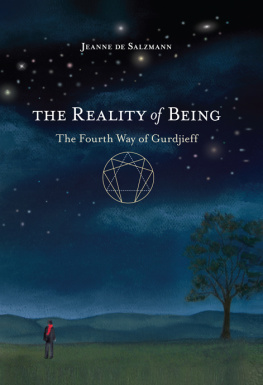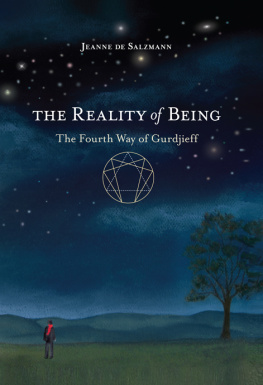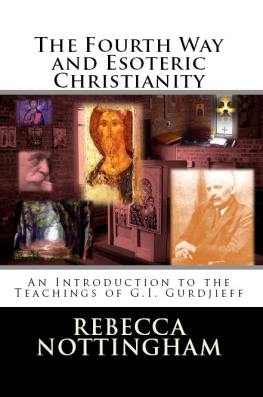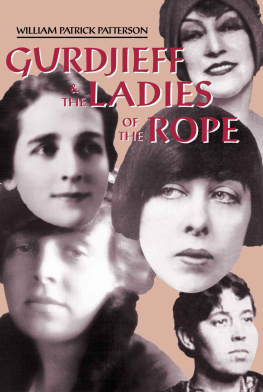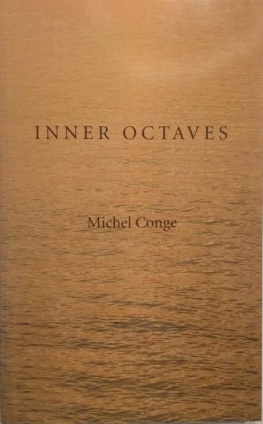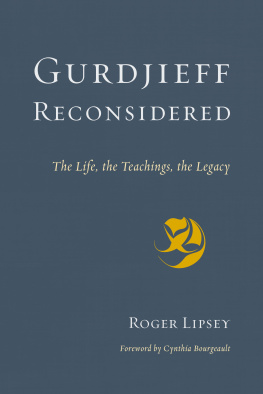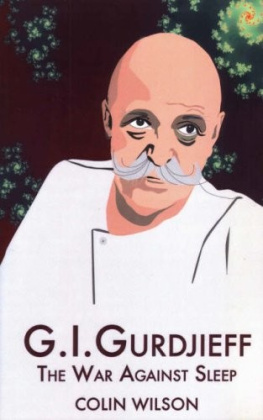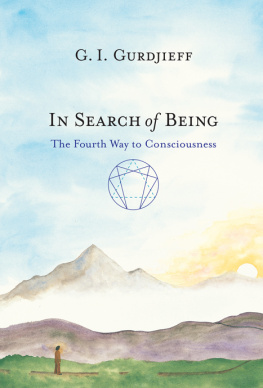A work that offers a long-needed clarification and exploration of what G. I. Gurdjieff called the Fourth Way. Madame de Salzmanns writing style will strike outsiders as having the clarity of reporting and the concentration of poetry. The light she shines is a watershed event in the development of the teaching, and in spiritual search in the West. With the publication of her book, she joins Gurdjieff and other great masters from other times and traditions who have dedicated their lives to bringing the incomparable gift of true consciousness, true love, and true being to the world.
Tracy Cochran, Parabola magazine
ABOUT THE BOOK
As the closest pupil of the charismatic spiritual master G. I. Gurdjieff (18661949), Jeanne de Salzmann was charged with carrying on his teachings of spiritual transformation. Known as the Fourth Way or the Work, Gurdjieffs system was based on teachings of the East that he adapted for modern life in the West. Now, some twenty years after de Salzmanns death, the notebooks that she filled with her insights over a forty-year period (and intended to publish) have been translated and edited by a small group of her family and followers. The result is this long-awaited guide to Gurdjieffs teaching, describing the routes to be traveled and the landmarks encountered along the way. Organized according to themes, the chapters touch on all the important concepts and practices of the Work, including:
- awakening from the sleep of identification with the ordinary level of being
- self-observation and self-remembering
- conscious effort and voluntary suffering
- understanding symbolic concepts like the Enneagram
- the Gurdjieff Movements, bodily exercises that provide training in Presence and the awareness of subtle energies
- the necessity of a school, meaning the collective practice of the teaching in a group
Madame de Salzmann brings to the Work her own strong, direct language and personal journey in learning to live that knowledge of a higher level of being, which, she insists, you have to see for yourself on a level beyond theory and concept. De Salzmann consistently refused to discuss the teaching in terms of ideas, for this Fourth Way is to be experienced, not simply thought or believed.
JEANNE DE SALZMANN (18891990) was born in France and pursued a career in music, dance, and theater. She met Gurdjieff in 1919 and became his closest pupil. Before his death in 1949, Gurdjieff directed de Salzmann to continue his work worldwide. She founded centers in New York, Paris, London, and Caracas, Venezuela. Madame, as she was called with respect, was an esteemed teacher in her own right, transmitting the Gurdjieff Work and especially his Movements, or sacred dances.
Sign up to learn more about our books and receive special offers from Shambhala Publications.

Or visit us online to sign up at shambhala.com/eshambhala.
THE REALITY of BEING
The Fourth Way of Gurdjieff

Jeanne de Salzmann

SHAMBHALA
Boston & London
2011
Shambhala Publications, Inc.
Horticultural Hall
300 Massachusetts Avenue
Boston, Massachusetts 02115
www.shambhala.com
2010 by the Heirs of Jeanne de Salzmann
All rights reserved. No part of this book may be reproduced in any form or by any means, electronic or mechanical, including photocopying, recording, or by any information storage and retrieval system, without permission in writing from the publisher.
Library of Congress Cataloging-in-Publication Data
Salzmann, Madame de (Jeanne), 1889?1990.
The reality of being: to live the Fourth Way of Gurdjieff / Jeanne de Salzmann.1st ed.
p. cm.
Includes index.
eISBN 978-0-8348-2285-6
ISBN 978-1-59030-815-8 (hardcover: alk. paper)
1. Gurdjieff, Georges Ivanovitch, 18721949. 2. Fourth Way (Occultism) 3. Spiritual life. I. Title.
BP605.G92S36 2010
299.93dc22
2010006464
GEORGE IVANOVITCH GURDJIEFF (18661949) regarded knowledge of realitywhat he called true knowledge of beingas a stream flowing from remote antiquity, passed on from age to age, from people to people, from race to race. He viewed this knowledge as the indispensable means to achieve inner freedom, liberation. For those who seek to understand the meaning of human life in the universe, he said, the aim of the search is to break through to this stream, to find it. Then there remains only to know in order to be. But in order to know, he taught, it is necessary to find out how to know.
Gurdjieff respected traditional religions and practices concerned with spiritual transformation, and pointed out that their different approaches could be subsumed under one of three categories: the way of the fakir, which centers on mastery of the physical body; the way of the monk, based on faith and religious feeling; and the way of the yogi, which concentrates on developing the mind. He presented his teaching as a Fourth Way that requires work on all three aspects at the same time. Instead of discipline, faith or meditation, this way calls for the awakening of another intelligenceknowing and understanding. His personal wish, he once said, was to live and teach so that there should be a new conception of God in the world, a change in the very meaning of the word.
The first demand on the Fourth Way is Know thyself, a principle that Gurdjieff reminded us is far more ancient than Socrates. Spiritual progress depends on understanding, which is determined by ones level of being. Change in being is possible through conscious effort toward a quality of thinking and feeling that brings a new capacity to see and to love. Although he said his teaching could be called esoteric Christianity, Gurdjieff noted that the true principles of Christianity were developed thousands of years before Jesus Christ. It could also be called esoteric Buddhism, as later studies have discovered. In order to open to reality, to unity with everything in the universe, Gurdjieff called for living the wholeness of Presence in the experience of I Am.
When Gurdjieff undertook to write All and Everything, his trilogy on the life of man, he envisioned the last book as the Third Series titled Life Is Real Only Then, WhenI Am. His stated aim for this book was to bring the reader to a true vision of the world existing in reality. Gurdjieff began work on it in November 1934 but stopped writing six months later and never completed the book. Before his death in 1949, he entrusted his writings to Jeanne de Salzmann, his closest pupil, and charged her with doing everything possibleeven impossiblein order that what I brought will have an action.
At the time of his death, Gurdjieffs followers were scattered across Europe and America. Mme. de Salzmanns first task was to call them to work together. The second was to give the teaching a form for practical work toward consciousness. In the forty years after Gurdjieffs death, she arranged for the publication of his books and the preservation of his dance exercises, called the Movements. She also established Gurdjieff centers in Paris, New York and London, as well as Caracas, Venezuela. In these centers she organized groups and Movements classes, whose participants referred to their collective engagement as the Work. Today, through the efforts of these pupils and other followers of the teaching, Gurdjieffs ideas have spread throughout the world.
Next page
